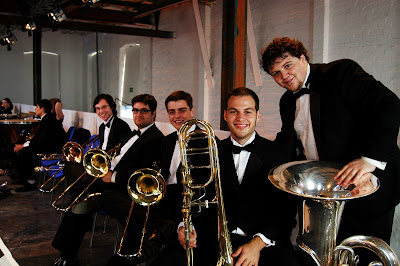
For many young musicians, this tour is their first trip out of the United States, to Europe or into Germany. After arrival at Berlin’s Tegel Airport, the Orchestra makes its way to Rostock, and the three hour bus ride through the wooded Mecklenburg-Vorpommern countryside goes quickly. Jet lag is just a state of mind when such exciting times loom ahead. The chatter of what to expect in Germany, in the concert halls, in the tour cities, the food, the people; fills the buses as the Orchestra arrives and explores the town of Rostock.


With a population of just under 200,000, Rostock has a rich seafaring history dating back to the middle ages, and soon became a powerful member of the Hanseatic League in the 14th century. Large sailing ships were built in its shipyards from medieval times until the 19th century, where the first German steamships were built. The University of Rostock, one of Northern Europe’s oldest, was founded here in 1419 and had as a professor one Albert Einstein.


For most, Rostock is the first glimpse of what used to be East Germany. After being defeated in World War II, Germany was divided into 4 sectors, each controlled by one of the victorious allies. While the western sectors controlled by the Americans, British, and French were to become a revived democratic Germany, the northeastern sector was controlled by the Russians, who, in the years following the war, shut off its borders and formed a communist state as part of its eastern bloc of puppet states, separate and isolated from its western neighbors and countrymen. This was not just the start of the cold war between Russia and the US, but was a terribly difficult time for Germans. Borders were sealed and friends and family separated, almost overnight … travel was restricted, friends and families separated and unable to see each other, cut off from communication and contact. Under decades of communist rule, life in East Germany was hard, economic woes and oppression took its toll on the people, cities and culture of this half of Germany. But, the eventual fall of the eastern bloc through peaceful demonstrations in the late 80’s finally broke down the walls that separated Germans from Germans for almost 40 years. Today, the east is once again part of a united Germany, and the long task of revitalizing and redeveloping this part of the country is under way. But I digress….
Given Rostock’s history as an important shipbuilding town, it is only fitting that the Youth Orchestra’s first concert venue is...a former shipyard.

The Neptune Shipyard when active decades ago

The Neptune Shipyard today
Built in 1891, the former Neptunwerft shipyard is part of the slow but steady revitalization of eastern Germany, as old industrial complexes are converted into art galleries, performance spaces, residential or commercial buildings. The old shipyard is now used an über-hip industrial chic concert venue, used by the Mecklenburg-Vorpommern Festival, which presents the SFSYO concert here in Rostock. The YO performs in “Hall No. 207, Neptune Shipyard.” Not the most romantic sounding name for a concert hall, but the venue works.
Arriving at the concert hall for rehearsal, the unique surroundings make one wonder about acoustics, but those worries are laid to rest immediately as the hall delivers a brilliant sound. Natural light floods in from the glass roof, and the sound carries nicely throughout the outer reaches of the shipyard.



In Rostock, the YO is joined by 34 year old Lithuanian-Austrian violinist Julian Rachlin, as soloist with the Orchestra at this concert and throughout the tour. Rachlin still holds the honor of being the youngest violin soloist to perform with the Vienna Philharmonic. Here in Rostock, Rachlin and the Orchestra perform the Sibelius Violin Concerto.

Julian Rachlin in rehearsal with the YO
The urban industrial chic shipyard concert hall is filled to the brim on this Saturday night, as almost 800 Rostockians make their way to the Shipyard to hear the YO. A few dignitaries dot the crowd: the Rostock mayor, the Music Director of the North German Philharmonic, Rostock Television, and the local newspaper Ostseezeitung are all here to hear this talented group.



Julian Rachlin with SFSYO concertmaster Hannah Tarley

SFSYO Music Director Benjamin Shwartz


And the YO delivers with a magnificent performance for their opening act of the 2008 European Tour. On the program tonight John Adams’ Lollapalooza, the Sibelius Violin Concert with Julian Rachlin and Dvorak’s Symphony No. 9 From the New World. And this talented group of young musicians from the New World is rewarded by the appreciative and attentive audience with three curtain calls. A wildly successful opening to the tour and a well deserved snack of milk and cookies awaits before heading home to the hotel. It's off to the capital tomorrow...Berlin awaits!
